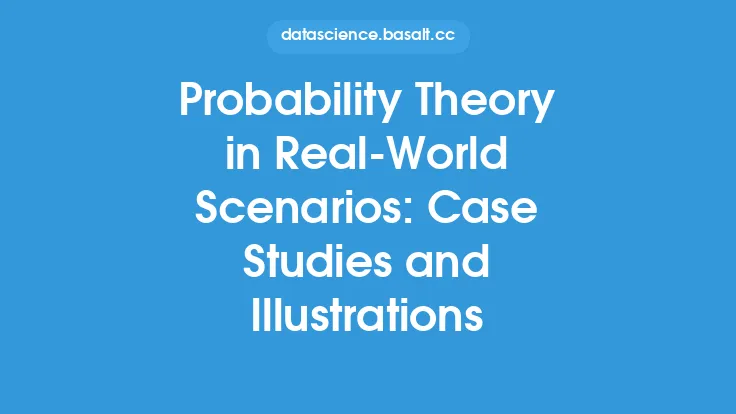Probability theory is a branch of mathematics that deals with the study of chance events and their likelihood of occurrence. At its core, probability theory is concerned with understanding and quantifying the uncertainty associated with random phenomena. The foundations of probability theory are built upon a few fundamental concepts, including events, sample spaces, and probability measures. In this article, we will delve into the details of these concepts and explore their significance in the context of probability theory.
Introduction to Events
In probability theory, an event is defined as a set of outcomes of a random experiment. Events can be thought of as subsets of a larger set, known as the sample space, which contains all possible outcomes of the experiment. For example, consider a coin toss experiment, where the sample space consists of two outcomes: heads (H) and tails (T). The event "getting heads" is a subset of the sample space, containing only the outcome H. Events can be simple, containing only one outcome, or compound, containing multiple outcomes. The study of events is crucial in probability theory, as it allows us to define and analyze the likelihood of different outcomes.
Sample Spaces
A sample space is a set that contains all possible outcomes of a random experiment. It is the universal set from which all events are derived. Sample spaces can be finite or infinite, depending on the nature of the experiment. For instance, the sample space for a coin toss experiment is finite, containing only two outcomes: H and T. On the other hand, the sample space for a random variable that can take on any real value is infinite. Sample spaces are often denoted using the symbol Ω (omega) and are used as the foundation for defining events and probability measures.
Probability Measures
A probability measure is a function that assigns a non-negative real number to each event in a sample space. This number represents the likelihood of the event occurring and is known as the probability of the event. Probability measures must satisfy certain axioms, including:
- Non-negativity: The probability of an event is always non-negative.
- Normalization: The probability of the entire sample space is equal to 1.
- Countable additivity: The probability of the union of a countable number of disjoint events is equal to the sum of their individual probabilities.
These axioms ensure that probability measures are well-defined and consistent with our intuitive understanding of probability. Probability measures are often denoted using the symbol P and are used to quantify the uncertainty associated with random events.
Sigma-Algebras
In probability theory, a sigma-algebra (σ-algebra) is a collection of subsets of a sample space that satisfies certain properties. A σ-algebra is a set of sets that is closed under countable unions and complementation. In other words, if a set is in the σ-algebra, then its complement is also in the σ-algebra, and the union of a countable number of sets in the σ-algebra is also in the σ-algebra. σ-algebras are used to define probability measures and are essential in the study of random variables and stochastic processes. The σ-algebra generated by a collection of sets is the smallest σ-algebra that contains all the sets in the collection.
Probability Spaces
A probability space is a mathematical construct that consists of a sample space, a σ-algebra, and a probability measure. It is a triple (Ω, Σ, P), where Ω is the sample space, Σ is the σ-algebra, and P is the probability measure. Probability spaces provide a framework for modeling and analyzing random phenomena and are used extensively in probability theory and statistics. The probability space is the foundation upon which all probability theory is built, and it provides a rigorous and consistent way of defining and analyzing probability measures.
Measurable Functions
In probability theory, a measurable function is a function that maps a sample space to a set of real numbers in a way that is consistent with the σ-algebra. Measurable functions are used to define random variables, which are functions that assign a real number to each outcome in the sample space. Random variables are used to model and analyze random phenomena, and they play a central role in probability theory and statistics. Measurable functions are essential in the study of probability theory, as they allow us to define and analyze random variables and their properties.
Conclusion
In conclusion, the foundations of probability theory are built upon the concepts of events, sample spaces, and probability measures. These concepts provide a framework for understanding and quantifying the uncertainty associated with random phenomena. The study of probability theory is essential in a wide range of fields, including statistics, engineering, economics, and computer science. By understanding the foundations of probability theory, we can develop a deeper appreciation for the subject and its applications, and we can gain insights into the underlying mechanisms that govern random phenomena. The concepts discussed in this article provide a solid foundation for further study and exploration of probability theory, and they are essential for anyone interested in understanding the subject.





